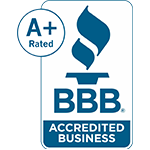Asphalt parking lots may be found in almost any commercial or residential neighborhood. However, numerous myths and misconceptions concerning their maintenance have lasted for many years. These beliefs can lead to inaccurate assumptions and maintenance practices that could potentially cause more harm than good. Below are some of the most popular myths and the truth behind them when it comes to asphalt parking lots and their maintenance.
Myth: Asphalt paving is maintenance-free.
Asphalt paving is a popular alternative for parking lots because of its longevity, and attractive appearance. Many individuals, however, think that once the asphalt is placed, it will require no additional care. However, to extend the life of an asphalt parking lot, regular maintenance such as crack filling, sealcoating, and pothole repair is required. Crack patching is required because pavement fractures and allows water to infiltrate and degrade the underlying base.
In contrast, if the cracks are not fixed they will expand and eventually cause more severe damage, such as potholes. Sealcoating is another maintenance routine for your asphalt paving that adds a protective coating to the asphalt’s surface. It protects the asphalt from the weather and keeps it from drying up and becoming brittle. Lastly, Potholes can be a typical issue in asphalt parking lots, and they can be caused by water infiltration or freeze-thaw cycles. Pothole repair prevents future parking lot damage and ensures a smooth driving surface. To prevent these issues it is vital to seal and repair cracks before they grow into larger issues such as potholes.
Myth: Sealcoating is not necessary for new asphalt.
As previously mentioned, sealcoating is necessary for the general maintenance of asphalt parking lots. However, Sealcoating is sometimes assumed to be only essential for older, worn-out asphalt surfaces, but this is a misconception. In contrast, sealcoating can help preserve new asphalt against damage caused by elements, chemicals, and other environmental factors. It can be thought that new asphalt is impenetrable and does not require care, but this could not be further from the truth.
Damage to new asphalt can occur from a variety of sources. For example, sunlight may cause asphalt to dry out and become brittle, making it more prone to cracking and pitting. Moisture and chemicals can also infiltrate the surface and cause internal damage. You may help prevent these problems and extend the life of your new asphalt by sealing the surface with a protective layer of sealant. Sealcoating also helps to keep your asphalt looking good by restoring its dark, rich color and providing it with a smooth, uniform appearance. This may improve the appearance of your property and potentially add value to your space. Furthermore, sealcoating is a worthwhile choice that may help you save on repair expenses in the long term.
Myth: Pouring hot asphalt in cold weather is a bad idea.
There has been a popular misconception that laying hot asphalt in cold weather is a poor idea. The fact is that hot asphalt may be laid in cold weather conditions, but with certain precautions to assure good curing. One of the most serious concerns with pouring hot asphalt in cold weather is that the material would cool too rapidly, causing cracking and other problems down the road. contractors would use insulating blankets to keep the asphalt warm and at the proper temperature for curing to reduce this danger.
These insulating blankets work by trapping heat and keeping the asphalt at a constant temperature, allowing it to cure correctly and attain its maximum strength and durability. Furthermore, it is critical to maintain the asphalt surface clear of snow and other debris, because this might impede the curing process and cause difficulties later on. Overall, pouring hot asphalt in cold weather is not generally a terrible idea, but it does need careful planning and the implementation of additional procedures to ensure good drying. Professional contractors may effectively apply hot asphalt in cold weather while maintaining a clear surface by using insulating blankets and maintaining a clean surface.
Myth: Cracks in asphalt are just cosmetic and do not affect the parking lot’s functionality.
Cracks in an asphalt parking lot are sometimes seen as only aesthetic, but they are far more serious. If not fixed, these fissures can rapidly develop into potholes, causing car damage and possibly creating a safety issue. Cracks in the asphalt can also allow water to infiltrate into the underlying layer, causing the parking lot to deteriorate and become unstable. Water damage may cause the asphalt to become fragile and split even more over time, creating a vicious cycle of deterioration. The reality is that cracks in asphalt should not be overlooked since they may soon develop into a much larger problem if not handled promptly. While it may be easy to overlook cracks and assume that they would disappear on their own, it is critical to have them fixed. Ignoring the cracks will simply worsen the problem and make it more difficult to fix. Cracks may be plugged and sealed early on, preventing water from entering and causing more damage. Additionally, early repair is usually less expensive than repairing a larger problem that has grown over time.
Myth: Repaving is the only solution when an asphalt parking lot reaches the end of its life.
When an asphalt parking lot reaches the end of its useful life, the idea that repaving is the sole answer has been a common understanding for asphalt parking lots. However, this is not the case, and there is a more cost-effective option that can rejuvenate the surface and extend the life of the parking lot. Milling and topping the old asphalt can be an option. Milling is the process of removing the top layer of asphalt, which can be aged and damaged and then replacing it with a fresh layer of asphalt. This method preserves the existing foundation and base, saving on time and expenses. Furthermore, grinding and covering the existing asphalt decreases trash generation throughout the operation, which can be better for the environment. The lower quantity of work and materials required contributes to the value-added of grinding and overlaying old asphalt. In contrast, repaving requires the removal of the whole asphalt surface, including the foundation and base, which needs a large amount of time and resources. This method can create difficulty and disturbance to the parking lot’s regular operations.
Understanding the reality behind these five popular myths regarding asphalt parking lot maintenance is critical for guaranteeing your parking lot’s durability and attractiveness. By understanding the facts and applying proper maintenance procedures, you can extend the life of your asphalt parking lot and avoid future costly repairs. Regular inspections, timely repairs, and correct maintenance practices are critical to keeping the aesthetic and operation of your parking lot.














